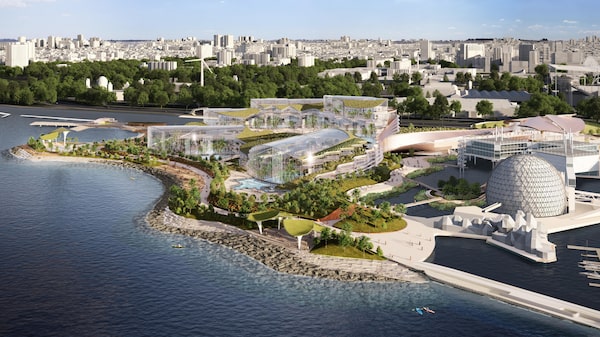
A sketch of the potential redesign of the planned Therme development in Ontario Place.
In the mid-20th century, public buildings were the most prestigious jobs an architect could get. Avant-garde aesthetics and social democracy went together. Ontario Place, a waterfront park accented by cultural venues, was a shining example of this tradition.
What’s happening now to Ontario Place is very different. The biggest piece in the site’s “revitalization” is a commercial indoor waterpark run by Therme Canada. The company will privatize, partially destroy and physically dominate the site.
Now the architects of that destructive project claim it is a gift to the public. In a recent Globe and Mail op-ed, Don Schmitt and Gary McCluskie of Diamond Schmitt Architects argued that the Therme facility is “social infrastructure” for which we should be grateful.
That is profoundly dishonest. Mr. Schmitt and Mr. McCluskie tell us their project serves the public good. The problem is that it’s not public – and it’s not good.
The term “public infrastructure” is borrowed from American sociologist Eric Klinenberg. In his book, Palaces for The People, which I covered in 2019, he argues that public amenities such as libraries “foster contact, mutual support and collaboration among friends and neighbours.”
In an increasingly dense Toronto, such amenities are crucially important. Public life is joyous; it is also a key to social coherence.
“How do we design cities to be more equitable?” Mr. Schmitt and Mr. McCluskie ask. “How do we plan to ensure that residents of the metropolis experience a greater degree of well-being?”
A great question. The main answer is simple: Public amenities. But the Therme facility would not be a public building. It would be privately run for profit, just like Budweiser Stage or a Cineplex. It would not be free to visit. It would not be the sort of place that people frequent daily or even monthly.
But it would be enormous – literally the size of a stadium. The main building would destroy all of the West Island of Ontario Place, which is now a public park that many Torontonians (including Mayor Olivia Chow) like to visit.
And it would be frankly ugly. Even in the drawings issued thus far, it is a hulking, top-heavy heap of glass and aluminum panel. The reality will be worse.
In compensation, Therme would fill in some of the lake around the edges to add what the architects call “12 acres of green park.” But that won’t be a public park – the province carefully has not used that phrase – and it will be marginal space, a strip between the hangar-sized waterpark and the actual water.
In short, the Therme project destroys more than it delivers.
But the architects tell us otherwise, spinning falsehoods and half-truths. Among them: the idea that “no public money” would go to support Therme, when that number is in the hundreds of millions – including direct spending on “infrastructure” for the West Island.
They also imply that “public consultation” and a “city planning review” give the building legitimacy – though the public and city planners have reacted with uncommon hostility. They even cite a speech in which critic Paul Goldberger called Therme facilities “the most democratic space I’ve ever encountered.” In an e-mail last week, Mr. Goldberger told me he was misquoted.
It’s sad to watch: prominent architects twisting themselves into rhetorical knots, claiming piousness while chasing a project that will earn them tens of millions in fees.
But it’s clear what is happening. The architects want to both keep the project alive and save their reputation. Architects who do public buildings must say idealistic things about the public good and the civic experience.
Jack Diamond, who was Canada’s most famous living architect, was a champion at such lofty patter. But he’s gone, and Diamond buildings these days are a mixed bag, widely varying in quality.
That’s true of public design across Canada. The standard of new architecture and landscape is much lower than it was 50 years ago – when Ontario Place was built, to fantastically ambitious designs by the offices of architect Eb Zeidler and landscape architect Michael Hough.
Today, nobody in government seems to care about design, and the procurement process rewards established players, cheap labour and aggressive business practices.
Diamond Schmitt thrives in this broken system. They look good on paper and continue to win important commissions. They also promote themselves as stewards of the common good.
But they can’t have it both ways: either they’re defending the public realm, or they’re building a 700,000-square foot attraction on it. They must choose.